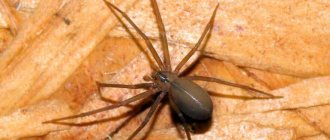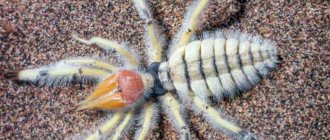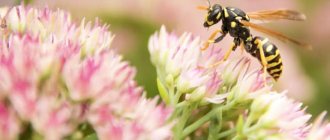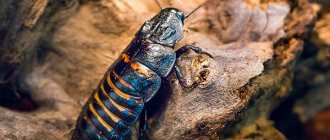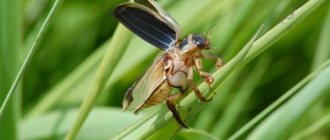Number of legs in spiders
The spider has 8 legs, but we must not forget that the class of arachnids includes about 40 thousand species, divided into 3 subspecies. They all differ in lifestyle, appearance and size. Their body has 2 parts: the belly and the cephalothorax, which are connected by a small tube.
The spider's legs are covered with small villi; on the foot of one leg there can be up to 3 thousand of them. The abdominal limbs are located on the cephalothorax. There are spines at the end of all legs, with the help of which the spider easily moves along the web. Between the spines there is a claw-shaped appendage; in certain varieties there is a claw instead. The legs consist of various segments:
- hip and knee area;
- trochanters;
- paws;
- shins;
- heel and pelvis.
The claw part is not a true segment, since in certain animals it is not separated from the tarsus. The hind and front legs are the largest. The second pair is the shortest, the third has an average length.
In many species, the approximate size of the legs is about 3 cm, in others it varies between 20-40 cm. There are species of arachnids that catch their prey with the first and second pair of limbs, because they are more developed and can be longer than others. The size of the spider's legs will depend on the place of residence and lifestyle characteristics. Apart from movement, the limbs do not perform any other functions, therefore they are walking. Taking into account the species, the size of the spider can vary between 0.3-12 cm, and the paw span can be up to 40 cm.
Having considered how many legs a spider has, it should be noted that their number differs from the number of legs in insects. Arachnids have 8, insects have 6. All have 6 joints. When counting, it turns out that they have 48 tribes.
How does a spider weave a web?
The thread of the web consists of many thin threads, which the spider glues together with a special liquid that quickly hardens in air. Thanks to this, the strength of the web is achieved so high that spiders even travel with its help, covering kilometers of distance.
The web can be dry, sticky, elastic - it all depends on the purpose of the thread.
Types of threads for webs:
- for cocoon
- catching sticky thread
- for moving
- to entangle prey
- thread for fastening
The design of the web depends on the hunting method. When weaving, spiders use a thread that reflects ultraviolet rays, which most insects see. Moreover, the spider weaves ultraviolet-reflecting threads in such a way that they look like flowers, which also reflect ultraviolet. Therefore, insects fly to an alluring and sweet flower and end up in a web.
Stages of weaving a web:
- The spider releases a long thread first. Such a thread is picked up by the air flow, rushes to the nearest branch and clings to it (Fig. 1, 2).
- Then another free-hanging thread parallel to the previous one is woven. The spider moves to the middle of this thread, which is stretched under its weight, and weaves another thread in a downward direction until it finds a third support (Fig. 3).
- The spider attaches a thread to the support and forms a Y-shaped frame.
- Next comes the general contour and several more radii (Fig. 4).
- An auxiliary spiral is woven at these radii (Fig. 5). This entire frame is woven from non-sticky thread.
- Next, the spider weaves a second spiral with a sticky thread, towards the middle of the web from its edge.
Construction may take 1-2 hours.
Tarantula spiders mating
Difference from insects
The spider belongs to the class of arachnids, it is not an insect . Characteristic features of this type:
- The main difference between arachnids and insects is that the last 6 legs are located on the chest, and not on the cephalothorax. In addition to external differences, animals have different structures of internal organs.
- Centipedes are also not insects, since they belong to a separate species.
- If we compare the body structure of arachnids with other creatures, it can be more closely related to a scorpion.
Spiders that live in apartments cannot harm the human body. You need to pay attention to sanitation conditions. Animals live in houses where there is enough food to remove them, it is necessary to get rid of the main cause of the invasion.
Spiders - what are they: types
Researchers know about 42 thousand species of spiders. Spiders can be divided into three large suborders, which differ mainly in the structure of the jaws, or more precisely, in the position of the chelicerae relative to the longitudinal axis of the body.
More often, representatives of this suborder are called migalomorphs. They are characterized by the presence of thick hairs, large sizes and a primitive structure of the jaws - the claw is directed downwards and grows only on the upper jaw. The respiratory system is represented by pulmonary sacs.
The majority of mygalomorphs live in warm climates. They make burrows underground.
Orthognatha includes:
- tarantula spiders
- funnel spiders
- ctenizidae
- digger spiders
Representative of the suborder Araneomorpha
Almost all other species of spiders known to naturalists belong to the large group Labidognatha or Araneomorpha. They differ in that both jaws are equipped with claws. The respiratory system is represented by the trachea.
We invite you to familiarize yourself with Cattle Bile and its Applications
Types of spiders that catch prey without a net:
- crab spiders
- jumping spiders
- wolf spiders
Types of spiders using a trapping net:
- linifid spiders
- web spiders
- funnel spiders, or house spiders
- long-legged spiders
- orb weaving spiders
Among the araneomorphic spiders, there are also those that are not capable of producing cribellum, the substance from which spiders produce strong web silk, and those that produce it.
Suborder Mesothelae
Lyphistiomorphic spiders are distinguished by the fact that the chelicerae are spread out to the side rather than pointing downwards. This position is considered more evolutionarily advanced. But this suborder is considered the most primitive; traces of it were found in Carboniferous deposits. Spiders have archaic pulmonary sacs and four pairs of arachnoid warts, which have not yet been moved to the end of the abdomen.
These include:
- arthropod spiders
- primitive arthrolycosid spiders
- primitive arthromigalid spiders
Blue tarantula spider
The main purpose of the paws
All spiders have limbs that perform the same function, and it makes no difference what species the individual belongs to. They move using their walking paw, which is their main one. The method of movement and speed of arachnids may differ, as it depends on the structure and size of the legs . The forelimbs help arthropods:
- Determine whether the prey is suitable as food.
- Grasp and hold the victim tightly.
- Place your babies on the back and throw them out of there. Moreover, they throw children over very long distances.
- Make a cocoon and create a web.
- Resist attacks from predators.
- Dig holes.
- Move across the surface.
Small hairs on the legs help animals sense touch, learning about the external environment. With their help, they are well oriented in space, can hear sounds and smell. Before starting to move through unfamiliar territory, they first move their limbs in front of them, and only then move.
Foot sizes
The length, thickness and other dimensions of the legs depend directly on the animal’s lifestyle. Both the first and fourth pair of legs can be the longest. The second pair is always slightly smaller than the first. The third pair is the shortest. In some species, due to the fact that the first two pairs catch and hold prey, the front two pairs are longer than the back ones.
In terms of their structure, the front legs are much thicker than the other limbs. The hips are club-shaped. The paws are attached to the heel, forming an angle with the axis of the leg itself. This structure in some species allows the front pair to be used as tactile organs. They use the other three pairs to move.
Pedipalps and chelicerae
When counting how many legs a spider has, it is considered that arachnids have 10 legs. This is due to the pedipalps and chelicerae, which are located in front of the animal’s cephalothorax. They are quite long and look like paws. Their main task:
- The pedipalps are the second pair of legs, consisting of several segments. On the head part there is a chewing outgrowth with which the spider grinds its prey. The rest resemble a tentacle.
- Chelicerae are located near the mouth and have 3 parts that look like small claws. The outermost finger is movable. In certain species it has the shape of a claw or a pointed process, which consists of 2 parts. Due to this structure, the animal breaks through the prey's cover.
The task of the chelicerae and pedipalps is to grind prey, knead and chew it. Poisonous spiders, thanks to chelicerae, inject a toxic substance. When the victim dies, a certain amount of saliva is injected into it, after which the insides acquire a mushy consistency. The spider consumes the resulting pulp as food thanks to its sucking stomach. Fertilization of females occurs through the pedipalps.
Many arachnids may have fewer legs in their natural environment. They lose their legs in battles with predators, so for a full life, 6 limbs are enough for them, the eighth pair being a spare one. New paws do not grow in place of lost paws.
The structure of arachnoid legs and their function
With the help of sensitive delicate hairs located on the limbs, spiders recognize odors and pick up sound waves. This is how they sense the surrounding objects. When touching a victim, the arthropod immediately rushes forward and sinks its fangs.
Paws are also necessary for knitting webs. They have special glands that prevent the spider from sticking. With its legs, the arthropod fastens individual threads together and secures the entire network to the ground or surrounding objects. There are also dry areas, without sticky discharge. The spider remembers where it can and cannot go until the victim gets there.
We invite you to find out how long chinchillas live at home and in the wild
Species that live in water use their limbs to create a nest for themselves. They use their paws to carry small air bubbles into the nest.
Arachnids also use their legs for their own protection. If they sense danger, they will quickly begin to comb the poisonous hairs from their bodies. When they get into the eyes of the aggressor, a strong burning sensation appears. Often the predator will choose to retreat. The hair will grow back after shedding.
The female forms a cocoon with her limbs, and then places it on her body. Some species bury future offspring deep into the ground. Using their paws, the females lift the young onto their backs.
The main function is movement. For this purpose, 4 pairs of walking limbs are used.
Longest limbs
A rare species of giant spiders, Heteropod Maxima, lives in Asia. The span of its limbs can be more than 40 cm. This species lives in caves in the Khammouan region. Also long limbs have:
- Hunter. The size of the limbs is more than 32 cm. This species can cover about one meter in a second. When it appears, a ticking sound is heard.
- Goliath tarantula. Lives in the tropics of South America. The weight of the animal reaches 180 g, the size of the legs is 16 cm. It is the largest after Heteropod Maxim. The lifespan of males is no more than 7 years, females - up to 16 years.
- Tegenaria. Lives in people's homes all over the world, limbs are 8−14 cm long.
- Baboon giant. One of the types of tarantulas. Body length - up to 14 cm, legs - up to 22 cm.
- Camel spider. It lives in the desert, can move at speeds of up to 3 km/h, defending itself from predators, and makes a squeaking sound, this distinguishes it from other species. Size - up to 9 cm, leg length - up to 32 cm. Belongs to the class of the phalanges suborder. Lives up to four years.
- Nephila. These individuals are also known as the golden spider or tree spider. The length of females can reach up to 17 cm. They weave webs measuring more than one meter.
- Crab spider. The paws of these individuals resemble the claws of a crab in appearance, which is why they received the corresponding name. Lives in the crevices of trees. The length is up to 26 cm, there are villi on the body, and spines on the limbs.
- Colombian tarantula. Size including limbs - up to 25 cm. Lifespan of males - up to 4 years, females - up to 20 years.
- Brazilian tarantula. Often kept at home as an exotic animal. The female’s weight is up to 120 g, size is 14 cm, limb length is up to 36 cm. Life time is about 29 years.
Non-venomous spiders: list with names
There are no spiders that are not poisonous at all. Poison is necessary in order to paralyze the victim, for protection.
But the venom of most spiders found is not dangerous. In some cases, there is so little that no one will notice, or there will be redness and swelling. Although in isolated cases an allergy to spider venom is possible.
Frequently encountered that are safe for humans :
Common harvest spider . The size of the male is up to 7 mm, the female is up to 9 mm. Long-legged. They hunt in the dark. They like to gather in a group so that they look like a clump of fur. Weaves a non-sticky web. They scare off enemies by releasing an unpleasant odor.
Common jumping spider
Common jumping spider , more than 5 thousand species. This is a small spider, 5-6 mm in size, that loves to bask in the sun and is excellent at climbing glass. They are good jumpers, can jump up to 20 cm. They do not weave webs, they attack with a jump, and they have excellent eyesight.
Common cross
Common cross , more than 1 thousand species. Size up to 25 mm - females, up to 10 mm - males. On its abdomen there are several white spots forming a cross. They hunt using a round trapping net, which can reach 1.5 m in diameter.
Floral sidewalk spider
Floral sidewalk spider . Size up to 10 mm. It hunts from ambush, instantly grabs its prey and paralyzes it with poison. Doesn't weave networks. It has camouflage - if necessary, it changes color from rich yellow to white. Those that hunt on the bark of trees are brown in color, and those in the leaves are variegated.
House spider
House spider or funnel web spider , the most famous and widespread. The web weaves in a secluded place: on the ceiling, in the corner, behind the closet. The male is up to 10 mm in size, the female is slightly larger - up to 12 mm. The color is yellow-gray with brown spots.
Knitting spider
Knitting spider. The size of the female is up to 10 mm, the male is slightly smaller. The color is light yellow, sometimes greenish. On the underside of the elongated, seed-shaped abdomen there are two light stripes. They build circular nets with large “holes” designed for long-legged mosquitoes. They build webs near water and are able to run on water.
Silver spider
Silver spider. The size of the male is up to 16 mm, the female is up to 12 mm. A rare spider, adapted to live in sluggish freshwater. Can swim. The abdomen is covered with hairs to retain air, so the spider appears “silver” under water. A “bell” filled with air weaves in the water, where it lives: rests, leaves reserves, eats caught prey.
Tarantula spider
Tarantula spider (tarantula). Large, up to 20 cm with a leg span. They have a beautiful variety of colors. Weaving a web. Some species are completely harmless to humans; the bite of others may cause swelling, redness, itching, heat, and muscle cramps. No deaths have been reported. They are the ones most often kept in houses; females of some species live up to 35 years. Very easy to care for. Birdeaters can even be trained.
Brazilian wandering spider
Neighborhood with people
Certain species of arachnids live close to humans. They live in places where there is enough food. As a rule, insects are eaten, but the diet will depend on the type of spider . The most common houses are:
- Haymaker. Taking into account the subspecies, the length can vary between 3−12 mm. Moreover, his legs are 5 times longer than his body. It likes to make webs on windows, for which it is also called the window spider. To catch the prey, the animal needs to position itself upside down near the placed web. When prey becomes entangled in the net, the predator rushes towards it, bites it, and then injects poison.
- Tramp. They enter the house by accident. These spiders do not set up webs; they catch prey on the move. When everything edible is destroyed, the arthropod leaves the house, moving on.
- Brownie. This is a small yellow individual 6−12 mm long. There is a brown pattern on the body. Females are larger than males. Make a web in the form of a funnel.
Spiders appear in the house when there is high humidity and a large number of insects that rapidly multiply in these conditions and move from room to room: mosquitoes, fruit flies, beetles.
How do spiders reproduce?
- Males usually differ from females in size (the male is smaller), long legs, brighter coloring, and the presence of pedipalps, which appear in males only during the last molt.
- First, males weave a special sperm web. Although some types are limited to a few stretched threads. Then the spider applies a drop of sperm to the web and fills the pedipalps with sperm, with the help of which it introduces sperm into the female’s seminal receptacle. And he goes in search of the female.
- The spider finds the female by smell. Having found a suitable female, the male begins to cautiously approach. If the female is not in the mood for courtship, she will attack the spider and may even eat it.
- If the female looks favorably at the male, then the male begins to lure the female: he performs “wedding dances,” “clangs” his legs, and brings prey. Having appeased the female, the spider carefully approaches her, touches her with the tips of her legs, then touches her with her pedipalps and retreats. The male also “drums” on the substrate.
- If the female does not show aggression and “drums” herself, then the male carefully approaches and brings his pedipalps to the female’s genital opening. The act lasts for several seconds.
- Then the male runs away so that the female does not eat him. Although this happens quite rarely. In one season, a female can have several males.
- After 6-10 weeks, the female weaves a cocoon into which she lays up to 500 eggs. The female carefully guards the cocoon, holding it between the chelicerae. After another 5 weeks, the spiderlings appear.
Amazing facts
The world of spiders is very diverse. These are unique and charming animals:
- There is a separate subspecies of the spider family called phrynes. It includes approximately 60 individuals. They have certain characteristics, the main one being that they do not know how to weave a web. They have quite large legs, and the front jaws, intended for hunting, are very strong.
- Spiders have no skeleton, only a hard shell. Because of this structure, the size of all arachnids is small. There are no large specimens that are shown in movies. Otherwise, the animal would have died under its own weight.
- It has been proven that the web is stronger than steel and other metals that exist in the world. Scientists still cannot make it artificially.
- The number of eyes in spiders can range from 2 to 12, and not 8, as many people think.
- During the hunt, arthropods react to vibrations. They can be recreated using a violin. To lure the spider out of its hiding place, you just need to play the instrument.
- The population of Cambodia keeps the tarantula spider as a pet, consuming the arthropod as food, as it is a magnificent delicacy.
- All varieties of spiders make a web in the shape of a circle, and only the gladiator makes a square, and the web of the orb weaver can reach up to 8 m in size.
Most people are terrified of spiders. This fear is called arachnophobia. However, in reality, these small representatives of arthropods have much more reasons to be afraid of humans. Spiders are the most unusual animals living on Earth. They received such fame due to the features that nature gave them.
Spider Science: What is it called?
Araneology is the science of spiders, which is part of the branch of zoology - arachnology. Arachnology studies arthropod invertebrate arachnids. The origin of the name is ancient Greek.
Also, arachnology is the art of weather prediction based on observing the actions of spiders.
Representative of the suborder Orthognatha
Experiments on spiders
More recently, an experiment was conducted in France, during which scientists tried to find out what would happen to a spider if it suddenly lost one or two of its legs. It turned out that they did not even notice their loss.
, in which all the paws are in place. Another container contained spiders that, for various reasons, had lost one or two of their legs. They were watched for some time. Scientists found out that spiders in both containers performed web weaving, food acquisition, and other vital procedures in the same way.
But the results of this study can be easily explained: nature itself took care of the spiders and gave them the back pair of legs as a reserve if the front legs were suddenly lost. By the way, there are a lot of such individuals. But unfortunately, it is almost impossible to find a spider web with 4 or 5 legs. Usually such a loss can threaten him with the loss of his life.
The longer the legs, the scarier the spider. Is it so?
Most of us have encountered insects such as spiders with long legs, which are gray in color and move very, very quickly. For some they are terribly frightening, for others they seem like specks of dust that can easily be blown away. However, few people know that these arthropods are not spiders at all.
In science they are called “haymakers”, but popularly they are simply called “false spiders”. Recognizing a harvestman and distinguishing it from a spider is very simple. The former have a dismembered abdomen, which almost completely merges with the cephalothorax. Spiders have a complete abdomen, which is connected to the head by a thin membrane.
The importance of harvesting spiders in nature and human life
One long-legged spider kills 12 to 20 mosquitoes per day. This is especially true where the malarial plasmodium and mosquitoes from the genus Anopheles, which carry this parasite, are common. Spiders are also good against mosquitoes, carriers of Dengue fever.
Research shows that the web of centipedes has an antibacterial effect against E. coli, Staphylococcus aureus, Pseudomonas aeruginosa, etc. Moreover, Gram-positive bacteria are more vulnerable to the proteins that make up the threads of harvest spiders than Gram-negative ones.

